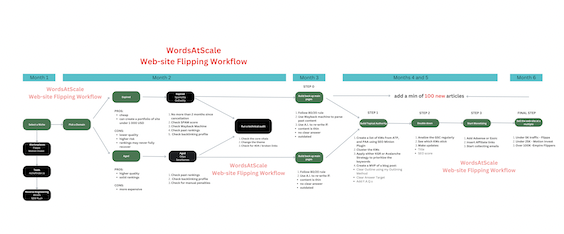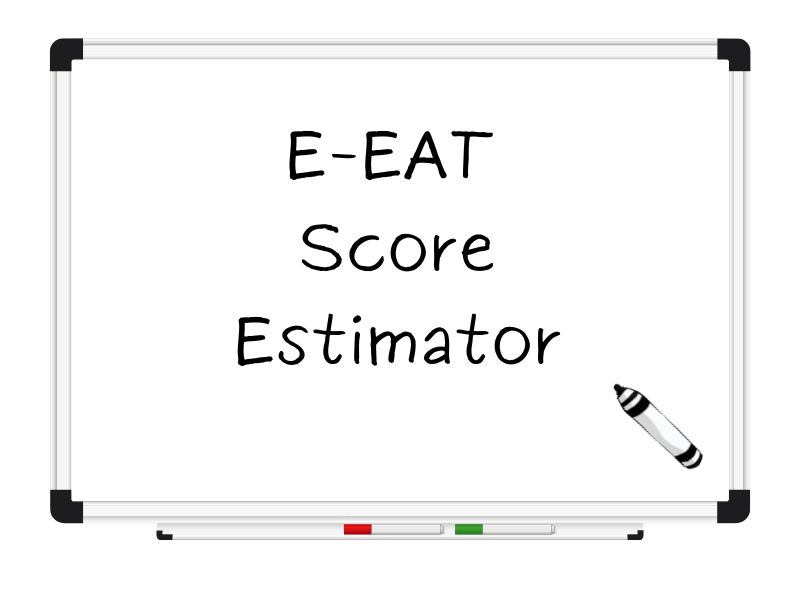Below is a 6-month workflow on how to pick a niche, buy and build up the website and then finally sell it at a profit.
Download the below Full Workflow for flipping a website

Table of contents
How to flip a website for profit?
To flip a website, one should start by researching for underperforming or in need of improvement websites in a niche or market that they are familiar with. Once a website is found, purchase it and work on improving it by updating the design, adding new content, and optimizing it for search engines. Next, monetize the website through advertising, affiliate marketing, or by selling products or services. Once the website is profitable, it can be sold for a profit. However, it’s important to keep in mind that flipping websites is a business and it requires knowledge, skills, and money. One should do their due diligence and be prepared to put in the work required to make the website profitable.
Month 1
Select a Niche first
When it comes to selecting a niche for flipping websites, there are many different methods and resources available.
To start off, you can use marketplaces such as Flippa and Motion Invest to browse through existing website opportunities. From there, you can then utilize tools like Ahrefs and Semrush to do further research into the potential of a website.
Additionally, services such as NicheFinder.io provide valuable analytics on various niches so you have access to reliable data when making decisions. Taking the time to explore all of your options upfront will ensure that you choose the right niche for flipping websites and make the best investments possible.
Pick you Domain type
Aged vs. Expired vs. New
Selecting a domain for flipping websites is an important part of the process, as it can greatly impact the value of the website.
There are three main types of domains to choose from: aged domains, new domains, and expired domains.
Aged domains are those that have been around for quite some time, often having a higher cost associated with them due to their age and established reputation.
New domains are fresh off the market and can be cheaper but might need more work in terms of search engine optimization (SEO).
Expired domains are previously registered names that have expired and recently become available again. These can provide greater potential for increasing value depending on its individual circumstances.
Ultimately, careful consideration needs to be taken in selecting a suitable domain based on factors such as its price, existing links and history, and potential growth opportunities.
Cons and Pros of Aged vs Expired Domains
Pros of Aged Domains
- Easier to start building SEO reputation
- Often have a high domain score and authority
- Higher value due to established age and reputation
Cons of Aged Domains
- Typically more expensive
- Difficult to find available domains in certain industries
Pros of Expired Domains
- Potentially cheaper than aged domains
- Established authority as expired domains often had an owner prior.
- May have existing backlinks, making them easier to improve their SEO ranking.
Cons of Expired Domains
- Difficult researching into the history of the domain
- May require additional work in terms of restructuring web design or content.
- Can come with a poor reputation if the last owner had unethical practices.
Buy your Domain
Where to buy an expired domain?
Buying an expired domain via Spamzilla and Godaddy Auction is a great way to acquire quality domains.
Using Spamzilla, you can access a large database of expired domains sorted by different metrics such as page rank, backlinks, etc. You can also view additional information about each domain such as its previous owner and Alexa ranking.
Godaddy Auction is another great option for buying expired domains. Through an auction-style marketplace, users are able to bid on the domain of their choice. The bidding process determines the price of the domain and allows savvy buyers to score quality deals on sought-after domains. Additionally, you can research further into the history of a domain before bidding on it by simply entering its name into a search engine.
What to look for in an expired domain
It is important to be careful when selecting an expired domain before purchasing. Here are a few key points to consider:
- No more than 2 months since cancellation – You should check the date of the domain’s expiry to ensure that it has not been expired for too long.
- Check SPAM score – It is important to evaluate the domain’s reputation by checking its SPAM score, as this will indicate how likely it is that you will receive spam messages sent from this domain.
- Check Wayback Machine – By using the Wayback Machine, you can look at the content of past versions of the website hosted on this domain, which might give you some insight into its previous use and potential risks associated with it.
- Check past rankings – You should also research into how well the domain was performing in search engines prior to expiring, as this will give you an idea of what effort may be required to get it back up and running again.
- Check backlinking profile – Finally, it is a good idea to investigate any backlinks that were pointing towards this domain in order to determine if there are any opportunities or risks associated them.
Where to buy an aged domain?
Purchasing an aged domain is a great way to get hold of a high-quality domain.
Godaddy Auction is one option for buying an aged domain, allowing you to take part in an auction-style marketplace and bid on the one that suits your needs. Additionally, you can research further into the history of a domain before bidding on it by entering its name into a search engine.
Brokers like Odys and SerpNames are another option for buying an aged domain as they provide more comprehensive due diligence processes and offer advice on whether or not to purchase a certain domain. These brokers also often have access to quality domains that are not available through regular marketplaces, so it can pay off to use them when looking for the perfect domain.
What to look for in an aged domain
When purchasing an aged domain, it is important to do your research and consider several factors before deciding whether or not to make the buy.
Firstly, you should investigate the past rankings of a domain in order to determine how well it performed prior to expiring. This will give you an indication of the effort required to get it back up and running again.
You should also check for any backlinks that were pointing towards this domain in order to assess whether there are any opportunities or risks associated with them.
Finally, you should be on the lookout for manual penalties that have been placed on the domain as these could hinder its performance and visibility when publishing content.
Run a quick SEO / Technical Audit
Running a technical SEO audit is essential when looking to improve the visibility and performance of your website in search engine results.
The first step should be to evaluate the core vitals of the website, such as page loading speed, mobile compatibility and security certificates. Updating these factors can make a significant difference to the overall user experience, which will also affect how your website ranks in search engine results.
Next, you should consider changing any existing themes or templates as this could help improve the design and usability of your site. It is also important to check for any broken links or 404 errors as these can have a negative impact on search engine rankings and can prevent users from accessing certain pages on your site.
Month 2
Build up your site with a 20/80 rule
When it comes to establishing an expired domain, the most important thing is to follow an 80/20 rule – focus on getting back the 20% of articles that had generated 80% of the past traffic.
Your first step should be to utilize websites such as the Wayback Machine in order to parse past content and decide what was working well for this domain in terms of linking structure, design, and user experience.
Once you have an idea of what worked well before, you can then consider using AI-driven tools to rewrite any weak or outdated content. If the content is thin or there is no clear answer regarding a certain topic, AI-based tools can help supplement it with useful and relevant information that aligns with your brand’s mission.
When building up an aged domain, the 80/20 rule still applies – focus on auditing the top performing posts and pages to see what can be improved.
AI-based tools can be used to rewrite any thin, outdated, or unclear content in order to ensure it is aligned with your brand’s mission and will provide a good user experience.
Additionally, formatting elements such as headings, bullet lists and tables can help improve the overall structure and readability of your website.
Months 3 and 4
Build Topical Authority
Topical authority refers to being recognized as an expert or thought leader in a specific industry or subject matter. In today’s digital age, having topical authority can be incredibly beneficial for businesses and individuals looking to establish themselves as a credible source of information and establish their brand as a leader in their field. To build Topical Authorityb you need to:
- Collect Keywords: The first step in building topical authority is to identify the keywords that are most relevant to your industry or subject matter. There are a number of tools available to help with this, including Answer the Public, Google Autosuggest, and People Also Ask. These tools can help you generate a list of keywords that are most commonly searched for by users and can provide insight into the questions and concerns that people have about your industry. You can also use plugins like SEO Minion to quickly parse hundreds of PAA keywords.
- Cluster Keywords: Once you have a list of keywords, it’s important to group them into categories. This will help you to understand the different topics and themes that are most relevant to your industry, and will allow you to focus your efforts on the areas where you can add the most value. There are a number of free and paid keyword grouping tools available, such as Keyword Cupid, Surfer SEO and others that can help you to organize your keywords and identify the most promising areas for content creation.
- Prioritise Keywords: One way to do this is by using a strategy called KGR (Keyword Golden Ratio) which involves identifying keywords that have a high search volume, but low competition. This can help you to identify the topics that are most in-demand, but where there is currently less competition. Another strategy is the SEO Avalanche strategy which involves identifying your site’s natural tier and only going after the keywords that match it.
Generate 100 pieces of content
Creating your first pieces of content can be a daunting task, but by following a clear outlining method, you can make the process a lot easier.
One effective method is to start with an MVP (Minimum Viable Product) approach when creating your first blog post. Here’s how you do it:
- Clear Outline: Before you start writing, it’s important to create a clear outline of your post. This should include the main points you want to cover, as well as any sub-points or supporting information. A good way to do this is by creating a bullet-point list of the key points you want to make, and then organising them into a logical structure. Use my Outline Extractor and the Perfect Outline workflow to achieve the best results.
- Clear Answer Target: When creating your outline, it’s also important to identify a clear answer target that addresses the search intent of your audience.
- Add F.A.Q.s to boost ranking chances: Once you have your outline and answer target, it’s a good idea to add in some frequently asked questions (F.A.Qs) to boost your post’s ranking chances. This can include questions that you anticipate your audience might have, as well as those that you’ve identified through keyword research. By addressing these questions in your post, you can increase the chances of your post ranking well in search engine results, and also provide your readers with valuable information.
- Writing the post: Once you have your outline, answer target and F.A.Qs, you can start writing your post. Keep in mind to be clear and concise, and to use simple language that’s easy to understand. Also, try to use the keywords you have identified throughout your post, but avoid keyword stuffing.
By following this MVP approach, you can create a solid foundation for your first blog post, and then build on it as you gain more experience and confidence in your writing.
Optimize regularly
Optimizing your MVP blog post is an important step in ensuring that it reaches the widest possible audience and has the greatest impact. One key aspect of this optimization process is analyzing the Google Search Console (GSC) regularly. This will give you insights into how your post is performing in terms of search engine ranking, clicks, and impressions.
By analyzing the GSC, you can identify which keywords are sticking and which are not. This can help you to understand which keywords are most relevant to your post and which ones are not resonating with your target audience. With this knowledge, you can adjust your post’s title, meta description, and content to make it more clickworthy and improve its search engine rankings.
Another tip is to make fewer updates to your post once it’s been published. This is because Google tends to favor older, established content over newer content. If you make too many updates to your post, it can be viewed as less authoritative, which can negatively impact your search engine rankings.
Finally, you can improve your post’s SEO score by using tools such as NeuronWriter or Surfer SEO. These tools can help you identify LSI keywords that help Google ‘read’ your content better by inclkuding the keywords that are currently missing, over or under used.
Overall, optimizing your MVP blog post by analyzing the GSC regularly, identifying which KWs stick, making fewer updates and improving your SEO score with tools like NeuronWriter or Surfer SEO are some of the key steps you can take to increase the visibility and impact of your post.
Months 4 to 5
Start monetising
Monetizing your website is a great way to generate revenue and support your business. There are several ways to monetize your site, including:
- Adsense or Ezoic: One of the easiest ways to monetize your site is by adding Adsense or Ezoic to your site. These are ads program provided by Google and Ezoic respectively, that allow you to display ads on your site and earn money based on the number of clicks or impressions.
- Affiliate links: Another way to monetize your site is by inserting affiliate links into your content. These are links to products or services that you promote, and for which you earn a commission for any sales made through your link.
- Email collection: Another monetization strategy is to start collecting email addresses from your visitors. By collecting email addresses, you can build a list of interested individuals and can send them targeted offers and promotions.
- Sponsored content: If your website has a good amount of traffic, you can also monetize your site by accepting sponsored content from other companies or brands. This means you can get paid to create content that promotes a specific product or service.
- Product sales: If you have a product or service to sell, you can monetize your website by creating an e-commerce platform and selling your products or services through your website.
- It’s important to note that monetizing your website may not happen overnight and it may take time and effort to see results. A good strategy is to start with one or two monetization methods and then test and optimize them over time. Also, keep in mind that the more unique and valuable your content is, the more likely people will be to engage with your monetization methods.
Month 6
Sell your website
Selling an aged or expired domain can be a great way to generate revenue, especially if you have put in the time and effort to build it up. However, timing is key when it comes to selling a domain, as the value of the domain can vary depending on a number of factors.
When you are around 6 months into your aged or expired domain, you should have produced at least 100 pieces of content and seen an increase in traffic. This is a good indication that the site has potential and is starting to gain traction.
The amount of traffic that your site receives is also an important factor to consider when selling your domain. Generally speaking, if your site receives less than 5,000 visitors per month, it may be best to sell it on a marketplace like Flippa. If your site receives between 5,000 and 25,000 visitors per month, Motion Invest may be a good option. And if your site receives over 100,000 visitors per month, Empire Flippers is a great marketplace to sell.
It’s important to note that these are just general guidelines and the value of your site may vary depending on a number of factors such as the niche, the quality of the content, the monetization methods, and the backlinks.
Additionally, you should consider the cost of selling, such as listing fees, commissions, and escrow fees.
In any case, it’s always a good idea to do your own research, and consult experts in the field before making a decision to sell your site.
Conclusion and final thoughts 💭
Aged and expired domains can be a great way to build an online business, but it’s important to understand the process and ensure that you are taking the right steps. Building an aged or expired domain requires patience and dedication, as well as careful planning and execution.
By establishing a timeline and following it closely, you’ll be able to maximize your chances of success with your aged or expired domain. From researching the perfect domain name to monetizing the website and eventually selling it for profit, there is no shortage of opportunities when working with aged or expired domains. Just make sure you stick to your plan!



